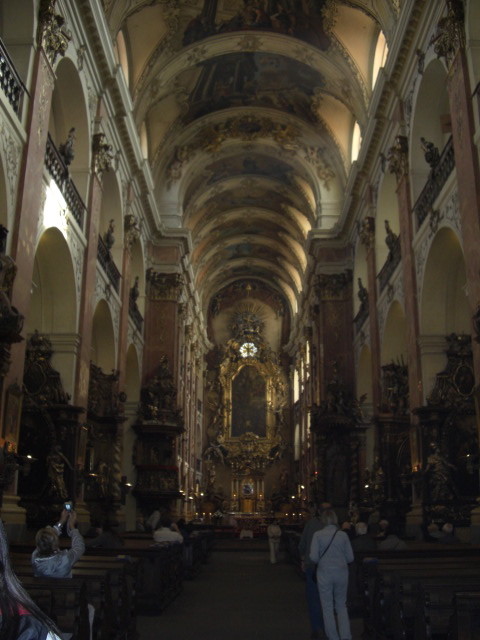In the Old Town, in Tynska, the sun blazing and threatening flames. It's a lovely quiet apartment on the ground floor with two cafés in the courtyards in front of it. Here for a few days.
First impression of great beauty: Venice without the canals. Alleyways, vaulted passages, old trees, cobbles, murals, relief scultpture, fantastica and phantasmagoria. A place for writers, readers, idlers, beggars and smart business-folk selling semi-surreal antiques clearly angled at the western eye...
Walked into two nearby grand churches, the first, in a quiet street behind us, being the Bazilika sc. Jakuba. The full Baroque splurge, screaming like a mad government official dripping with medals and frogging.

Here's what the website says about it:
The basilica was founded in the reign of Wenceslas I in 1232 in the close vicinity of the Old Town Square during the establishment of the Old Town of Prague. The original Gothic Minorite convent with the Church of St James the Great burnt out in 17th century. Following a reconstruction led by Jan Šimon Pánek Panecyus it is one of the most attractive Baroque buildings in Prague. The painters and sculptors involved in the decoration of the church were notable artists of the Czech Baroque and Classical period: Peter Brandl, Václav Vavřinec Reiner, Jan Kryštof Liška, Ignatius František Platzer and Ignatius Michal Platzer. The church, significant from the point of view of decorative art, the church has always been a place for concerts. What now remains from the original organ built around 1720 by Abraham Starck from Loket is only the richly ornamented case. The current organ is from 1970s and was designed as a universal concert organ. Probably two best known members of the Minorite Order worked here in the beginning of 18th century: the organist and composer Bernard Artophaeus (1651-1721) and his student Bohuslav Matěj Černohorský (1684-1742), prominent composer and teacher. The basilica has never ceased to be much-frequented concert venue.
Now to don my gilded wings, twist my body into a particularly expressive form of contrapposto, and head for lunch. I think I'm going to like it here.

No comments:
Post a Comment